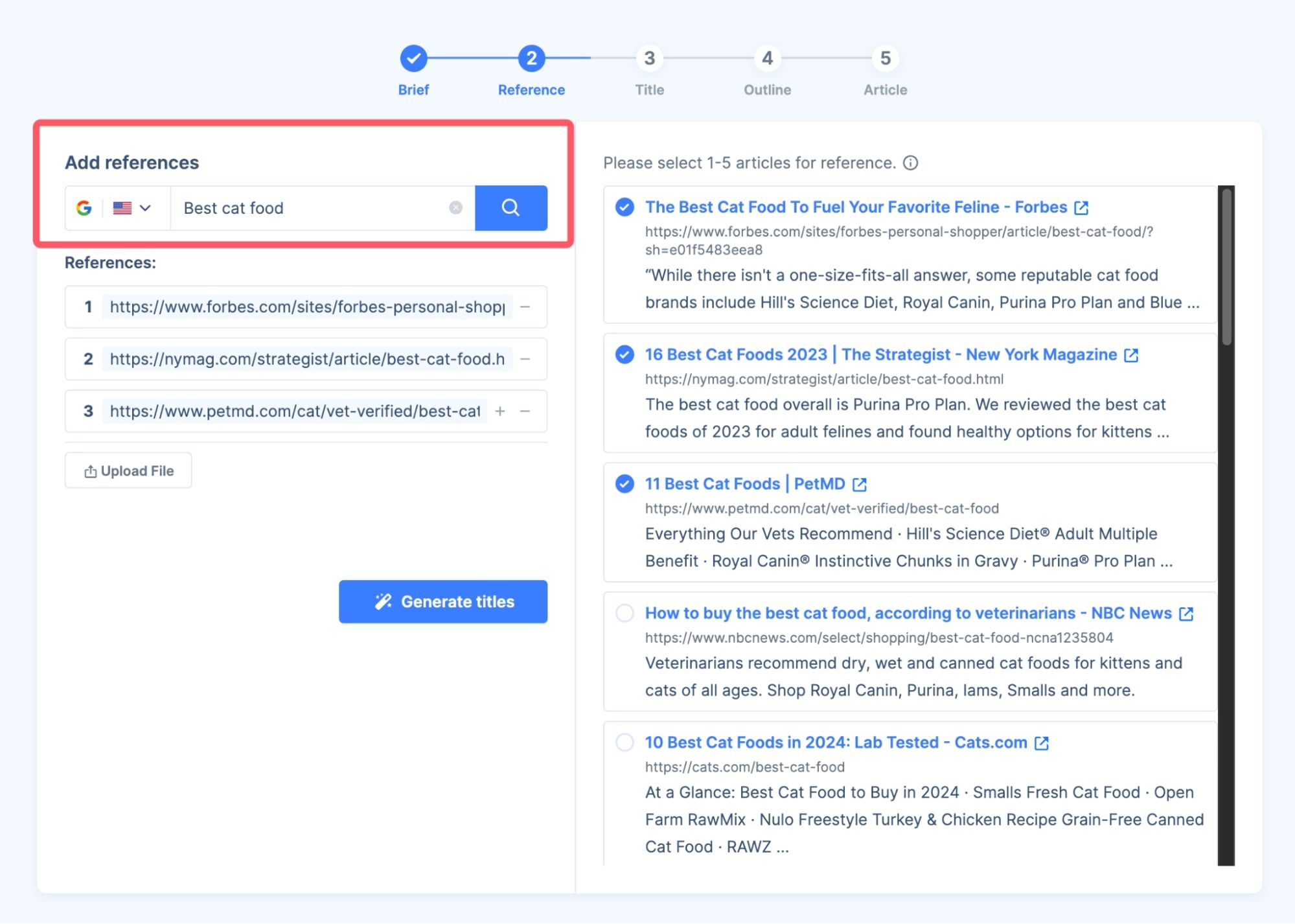You’ve written an article to attract more people to your website. The text is now online, and you can’t wait to see thousands flock to your platform.
But there’s an unpleasant surprise – the copy sparks little-to-no engagement. Only a handful of people have read your text, so what’s the problem?
The problem is that you didn’t write your content for SEO. While good content is a cornerstone of engagement, nobody will see it if it doesn’t incorporate SEO methods. This guide to SEO-friendly writing will help you rectify this by sharing tips on how to write SEO-friendly content.
What Is the Meaning of SEO-friendly Content?
Before you learn how to write an SEO article, you first need to understand what SEO-friendly actually means in the context of website content. The term SEO, or Search Engine Optimization, refers to strategies that maximize a website's visibility in search engine results, aiming to attract organic traffic.
When we say an article is SEO friendly, it means that it’s written to rank high in search engines like Google. It involves leveraging specific keywords, structuring content strategically, and ensuring readability to meet the algorithms' criteria, thus improving the chance that users will find and engage with the site.
Use AI to Write SEO-friendly Content With Ease
The fact is, that incorporating all the elements of SEO-friendly articles can be time-consuming, especially if you write content in bulk. You can easily overlook a keyword or use an inappropriate text length, ruining your chances of ranking high in Google search results.
If only there was a way to automate the process, and there is, and it’s called ArticleGPT. Part of HIX.AI’s fleet of AI-driven writing solutions, ArticleGPT lets you use advanced AI to write SEO-optimized content within seconds. It crafts high-quality, well-researched articles based on your input that require minimal editing on your part.

What makes ArticleGPT stand out is its ability to generate hallucination-free, fact-based, and SEO-optimized articles, ensuring that each piece is credible and primed for search engine success. Additionally, ArticleGPT is versatile and capable of producing a wide variety of high-demand article types to meet any content creator's needs.
In addition to the simple “one-click mode” for quick and easy content generation, ArticleGPT’s "high-quality mode" allows for more granular control over the article's details, enabling users to specify content references for the article to ensure the output closely aligns with your content strategy and SEO goals.

You can use the built-in reference system to search and handpick high-ranking websites with successful SEO strategies, offering insights you can apply to your content for a competitive edge. With the ability to mirror the SEO framework of industry-leading content, ArticleGPT equips you with the finesse to craft articles that are primed for top search engine performance.
Now, you’re probably thinking: “ArticleGPT can’t be the only tool for SEO article writing. Why should I use it over some other platform?” Thus, here are some of the primary reasons why ArticleGPT is superior to its competitors:
- Hallucination-free approach – ArticleGPT doesn’t make up content to meet the requested word count. Instead, it researches the topic thoroughly to generate factual copy and increase your credibility.
- Fact-based content creation – ArticleGPT is built around the principle of reliability, pulling from trusted sources to produce content that is both informative and verifiable, key factors in establishing your site as a reputable authority.
- SEO-optimized – ArticleGPT ensures that every article generated is fine-tuned with current SEO best practices in mind, positioning your content for better visibility and higher rankings in search engine results, thereby driving organic traffic to your site.
- Powered by cutting-edge AI technology – ArticleGPT features the GPT-3.5 engine, but you can also opt for the optional GPT-4 model to increase the quality of your content.
- Versatile content producer – With ArticleGPT, you can generate eight different kinds of articles, including single Amazon product reviews, general product roundups, how-to guides, news articles, product comparison articles, etc.
- Customizable input – Generic doesn’t exist in the ArticleGPT dictionary. You can fully customize your articles by changing the point of view, tone, and keywords. Not only that, but the tool even lets you write in multiple languages, which is perfect when targeting foreign audiences.
- Can write in bulk – You can rely on ArticleGPT to write individual articles, but you can also leverage the AI assistant for bulk content production, making it a handy solution for scaling up your content strategy and maintaining a consistent online presence without compromising on quality.
Why Should You Make Your Texts SEO-Friendly?
SEO-optimized content is essential for any website looking to gain traction and credibility in the digital space. It's essential for enhancing online visibility and shaping the reputation of your content. Here are the reasons why it should be a priority during your content creation process.
- SEO-friendly posts improve your search rankings – By incorporating keywords naturally, organizing your content correctly, and ensuring your content provides value, you can drastically improve your search engine rankings. The higher you rank, the more traffic you drive to your platform.
- SEO-friendly posts help you build authority – If you can post optimized content consistently, you’ll enhance brand awareness and build authority. People will start relying on your platform for valuable information and be more likely to visit your website rather than your competition.
- SEO-friendly posts can boost sales – The ability of SEO content to boost sales is directly linked to ranking higher in Google. Put yourself in the shoes of your audience to understand their motivation. Would you rather buy from one of the top five or bottom five search results on the first page? How often do you scroll down to the second page of the results? Your buyers think the same way.
- SEO-friendly posts save money – Optimized texts expand your online presence organically. They eliminate the need to buy expensive pay-for-click ads and other costly marketing solutions.
5 Tips to Make Your Content More SEO-Friendly
Now that you understand the basics of SEO and why it’s essential in your content strategy, here are five tips on how to produce and edit SEO-friendly content like a pro:
Tip #1 – Add Your Keywords Naturally
One of the things you can do to ensure people click your content is to fill it with relevant keywords that reflect their search intent. Contrary to popular belief, this doesn’t mean you should stuff your copy with keywords, randomly placing them in different parts of your text. It can make your articles nearly incomprehensible.
A much better approach to keywords is to place them naturally inside the text. Consider the context (the content before and after the keyword). If the keyword fits the context, feel free to incorporate it there. If not, put the term elsewhere or omit it altogether. It’ll make your copy more readable and SEO-friendly.
Anyone who knows how to write SEO content will also tell you this: you don’t have to put all the keywords in the text in one go. When you finish writing a piece of copy, you can look back and rewrite a paragraph to incorporate an additional keyword, since you then have a better idea of the keywords you’re missing.
Tip #2 – Use Catchy Headings
Another thing you should do to leverage SEO content for website performance is to use catchy titles. Think about it – the title of your article is the first element of the text people see when discovering your copy. If it seems irrelevant or bland, they’ll probably check out someone else’s article.
Therefore, be sure all your titles are engaging. Rather than write something like “How to Improve Data Science Skills,” use titles like “5 Tips to Become a Data Science Master.” This not only piques the reader's interest but also promises value, enticing them to click through and engage with your content.
The title isn’t the only heading you should focus on when optimizing your copy for SEO. Other headings are critical, too. The easiest way to make them more SEO-friendly is to use keywords. Sprinkle keywords across your headings naturally, and your readers will be grateful.
Headings also make it easier to incorporate difficult or ungrammatical keywords. For example, if the main keyword you need to include is “data science how to start,” adding it to the body of your article can be difficult. Instead, include the keyword into a heading to make it blend more naturally: “Data Science - How to Start Learning.”
Tip #3 – Choose the Right Text Length
No discussion about SEO article writing is complete without the appropriate text length. But in truth, there isn’t THE right text length for every type of content because there are different kinds of texts.
For instance, if you’re writing a blog post, your text should be at least 1,000 words long. Google favors content that meets this word count over those that don’t, ranking them higher in search results.
The standards for other types of content are different:
- Product descriptions: at least 300 words
- Taxonomy pages: at least 250 words
- Cornerstone pages: at least 300 words
While 1,000-word posts are the go-to choice for most authors, your pieces can be much longer. The key is to maintain the right keyword density, which is about 1-2%. This means that you should incorporate the target keyword approximately once every 100 words. For example, a 5,000-word text should have 50 instances of the target KW.
Tip #4 – Break Up Long-Form Content With Paragraphs and Linking Words
Readability plays a pivotal role in the SEO performance of your articles. It depends on several factors, including how well you organize your texts.
For example, if you’re writing a 600-word product description and only use three or four paragraphs, your SEO performance will take a toll. Such content is cluttered and hard to follow. Worst of all, the paragraphs likely have more than one subject, which also jars with the reader.
A simple way to avoid this and get SEO content is to break up your articles into more paragraphs. Some SEO tools (e.g., Yoast and SurferSEO) have minimum paragraph counts that determine how many paragraphs your text should have based on the length. For instance, a 1,000-word blog post should consist of 10-20 paragraphs to improve readability.
When breaking up your copy, don’t forget about linking words. Also known as transitional words, they introduce the reader to a related or contrasting subject, so they can follow the content more easily. Some of the most widely-used linking words are however, also, therefore, still, nevertheless, finally, then, additionally, again, and although.
Lastly, if you’re not sure how to write an article for SEO and keep it organized, bullet points can help too. You can use them for pretty much any kind of list, such as instructions, ingredients, and product benefits.
Tip #5 – Pay Attention to Meta Descriptions
Any author who wants to learn how to write for SEO needs to understand the ins and outs of meta descriptions. Meta descriptions are HTML components that summarize your content and provide the reader with the key information about the article.
Although they’re displayed right under your title in Google search results, they don’t impact the ranking of your website. Nevertheless, they can influence whether or not someone clicks the content. If the summary is compelling and relevant to the reader’s search intent, the person will be more likely to access the page.
To ensure this, not only you should add the target keywords to your description, but you should also limit the description to about 120 characters, with the idea is making your meta description fit neatly within the search results page without being cut off, thus maintaining clarity and effectiveness.
Master the Craft of Writing for SEO
Writing SEO content is largely a balancing act. You need to have the appropriate text lengths, the right number of keywords and headings, and many other factors.
The good news is that you’re not alone. Tools like ArticleGPT streamline content writing for SEO and require minimal effort on your part. Within seconds, you can produce some of the longest SEO-friendly articles to spark greater interest in your brand.



